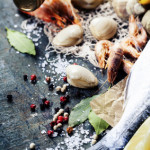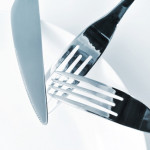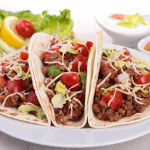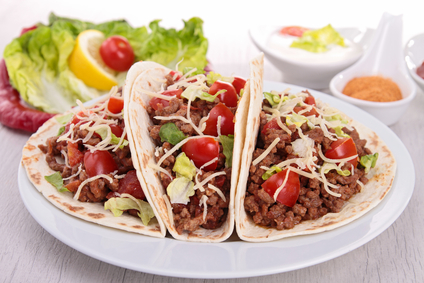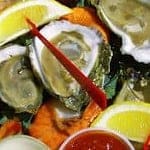Seafood
Keep your seafood fresh with safe handling and cooking tips.
Selecting Seafood
The first step in putting the best seafood on your plate is making sure that you put the best seafood in your shopping cart. Make the best choices at the store and you’ll enjoy great taste at the table every time.
When you’re shopping, make seafood the very last thing you pick up before you check out. Make sure to place it in an insulated bag for your trip home.
When purchasing clams and oysters in their shells, make sure they are alive. Shells of live clams and oysters may open naturally, but will close tightly when tapped, indicating that they are alive. Throw away any dead ones.
Fresh whole fish should have a shiny surface with tightly adhering scales, gills that are deep red or pink, free of slime, mucus and off-odor, and milk, briny aroma, similar to the ocean.
Fresh steaks, fillets, and loins should have a translucent look, fresh that is firm and not separating and a mild briny odor, similar to the ocean.
Handling Seafood
Shore to store is only one leg of the journey. It’s important to continue following safe handling recommendations once you take your seafood purchase home.
If your seafood is frozen make sure to thaw seafood in the refrigerator. Never thaw at room temperature.
Wash your hands with hot soapy water before and after handling raw seafood.
Thoroughly wash containers that held raw seafood before using them again.
Cooking Seafood
Now that your seafood is home safely, it’s time to get cooking.
Make sure that you cook fresh fillets and shellfish 1 to 2 days after purchasing.
Keep seafood refrigerated until it’s time to cook.
A general rule for baking and broiling fish is 10 minutes per inch of thickness at 400 to 450 degrees.
Fish is done when the flesh becomes opaque and flakes easily at the thickest part.
Scallops, clams, oysters, and shrimp become opaque and firm when fully cooked. Don’t overcook as this will result in loss of moisture, which affects texture and taste.
To boil, place shrimp and scallops in a large pot of boiling water (four cups of water per pound of meat) and simmer three to five minutes.
Broiled scallops and peeled and deveined shrimp will be cooked in 3 to 5 minutes.
Broiled shucked clams and oysters will be cooked in 3 to 5 minutes.
Oysters and clams should be steamed until their shells open completely. Throw away any that do not open.
Most seafood should be cooked to an internal temperature of 145 degrees. Consuming raw or undercooked seafood or shellfish may increase your risk of foodborne illness, especially if you have a medical condition.
“Work With What You Got!”
© Victoria Hart Glavin Tiny New York Kitchen © 2016 All Rights Reserved
Perplexing Foodstuffs
There are those foods that can be rather difficult to figure out how to eat without looking like you were born in a cave. Here are some useful tips for properly eating perplexing foodstuffs.
Artichokes
Pluck off artichoke leaves and scrape the tender part (not the prickly point) between your teeth (preferably after dipping in melted butter). Work your way to the delicate inner leaves, and then use a knife to cut off the remaining small leaves and feathery innards. Cut the artichoke “heart” into bite-sized pieces and eat with a fork.
Asparagus
Eat asparagus with your fingers if served raw as crudités. Eat with a fork and knife if served with dinner.
Bread
Break bread into bite-sized pieces, and butter it or dip it into olive oil just one piece at a time.
Crab (Soft-Shelled)
Eat entire crab, including shell, either in sandwich form or using a fork and knife. Remove inedible pieces from your mouth with a fork.
Fajitas
Place meats, vegetables, and other fillings on a flat tortilla. Roll up and use your fingers to eat fajitas from one end.
Fondue
Spear bread, vegetables, or fruit with a fondue spear and dip into cheese or sauce. Remove food from spear using a dinner fork, and eat from a plate. DO NOT double dip. Spear uncooked meat cubes and place spear into fondue broth or sauce. When cooked, transfer meat to a plate using a dinner fork and cut into smaller pieces to eat.
Lobster
Wear a lobster bib to avoid fishy splatters, Crack shells with shellfish crackers and extract meat with a small fork or pick. Cut larger pieces with a knife, and eat with a fork after dipping in melted butter. Clean your hands by dipping fingers into finger bowls, and use lemon (if provided) to cut extra grease. Dry your hands with your napkin.
Peas
Use a knife to push peas onto a fork. Do not mash peas before eating, or eat peas from a knife.
Raw Shellfish
Use a small fork to extract mussels, clams, or oysters from the half-shell. Season with fresh lemon or cocktail sauce. In informal settings, you may quietly slurp shellfish from shells.
Soup
Using a soup spoon, spoon soup away from your body and then quietly sip from side of spoon. Tilt bowl away from you to spoon up remaining drops.
Spaghetti
Twirl pasta with fork tines into bite-sized portions, and allow any dangling pieces to fall back onto your fork. You may also rest fork tines against the bowl of a spoon while you twirl pasta.
Steamers
Extract clam from shell using a small fork, and use a fork and knife to remove inedible neck. In informal settings, it is permissible to use fingers.
“Work With What You Got!”
© Victoria Hart Glavin Tiny New York Kitchen
Oysters
Oysters are a type of marine mollusk with a rough, irregular shell, found on the seabed of temperate coastal waters. Oysters have been cultivated as food for more than two thousand years; they are shucked and eaten raw, cooked, or smoked. The top of an oyster tends to be flatter; the bottom is more bowl shaped. On-the-half-shell oysters are left in the bottom half.
The flavor of an oyster is determined by the species and by its home waters. Oysters are classified by their point of origin: Pacific or Japanese, Atlantic or Eastern, and Olympia. Specific names usually indicate their exact point of harvesting. In general, Pacific oysters, such as Hama Hama, Hog Island, Quilcene, Tomales Bay, Wescott Bay and Kumamoto, are known for their creamy texture and slightly mineral flavor. Atlantic oysters, such as Cape Cod, Chesapeake, Kent Island, Long Island, Malpeque, Wellfleet, and Blue Point, have a saline, oceanic taste and crisp texture. The relatively small Olympia (originally from Puget Sound) has been overharvested in the past, but is making a comeback.
Fresh live oysters have a sweet, mild smell. The shells should be tightly closed and feel heavy. If an oyster stays open when touched, do not buy it. If you are eating them raw, the oysters should be fresh and shucked within a few hours before serving. Only buy shucked-for-you oysters that are plump with totally clear liquid.
Put live oysters out on a large tray and cover with a damp cloth. You can keep them in the refrigerator for one to two days, but make sure the cloth stays damp. Refrigerate shucked oysters in their liquor in an airtight container for up to two days. Frozen oysters can be kept for three to four months.
If you don’t have a Chesapeake stabber (an oyster-shucking knife), open the bivalves with an old-fashioned can opener, the kind some people call a church key. Scrub the oysters well with a stiff brush under cold running water. Rinse well before opening. Reserve the liquor. If you soak oysters in club soda for about 5 minutes, the oysters will usually be easier to remove from the shells. Hold an oyster, curved side down, in one hand on a folded kitchen towel. Locate the spot where the top shell meets the bottom shell at the pointed tip of the oyster. Holding the can opener, pointed end up, in your other hand, wedge the tip of it into the crack separating the shells, about 1/4 inch below the pointed tip of the shell. Push the end of the can opener downward, and the shell should pop open from the leverage. Run the can opener around the inside of the shell to open it completely. To loosen the oyster meat from the shell, run a dinner knife under the meat.

